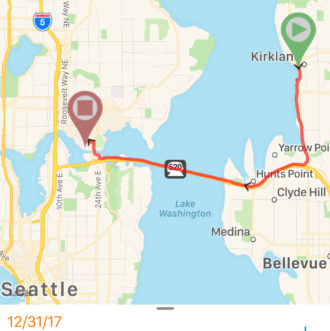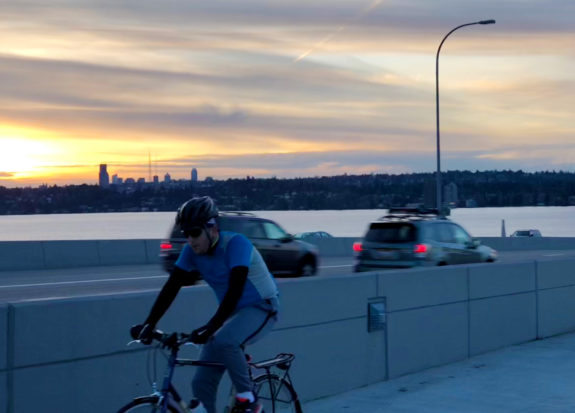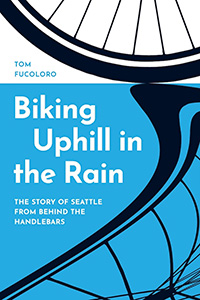
The trail across the new 520 Bridge opened just before Christmas, opening new possibilities for biking in the region.
For example, a trip from downtown Kirkland to UW Station has been cut in half, and you can make it most the way either completely separated from car traffic or in a painted bike lane. Even at a leisurely pace, the ride takes around 45 minutes.
A bike ride to downtown Bellevue would take a similar amount of time.
I knew this bridge connection was going to create new opportunities for more trips, but what I didn’t expect was how many kids I would see biking there on my first trip across. The trail was bustling, with lots of people walking and biking. But it seemed like about half of the people biking on the bridge were kids under 10 with their parents. This is certainly anecdata, and maybe it was just a quirk of it being New Year’s Eve or still being novel.


But there is definitely something about the design of the trail on the bridge and the connections on both sides that makes this trail far more comfortable and easy to use than the I-90 Bridge.
The new trail is significantly wider than the I-90 Trail, which makes it much more comfortable for people walking, families and commuters to all mix. There are also a series of viewing areas with benches to allow people to stop and take in the incredible views of the lake without being in the middle of the trail. Where the I-90 Bridge feels like a means to get across the lake, the 520 Bridge is also a destination of its own.
But perhaps most importantly, the connections are much better, especially on the Seattle side. Accessing the I-90 Bridge from Seattle is whimsical (there’s a bike tunnel!), but it’s not particularly easy or intuitive unless you live in the Central District or Mount Baker.
The 520 trail, on the other hand, is easily accessed from both UW Station and the Burke-Gilman Trail. You can get to and from these major pieces of car-free transportation infrastructure without ever mixing with busy traffic. And thanks to LimeBike, Spin and ofo, you can usually find a bike at UW Station you can hop on for $1 (I saw quite a few people bike share bikes on my trips across the bridge).
On the east side of the bridge, the trail does go up and down a couple significant hills between Evergreen Point and Lake Washington Boulevard. And you can still throw your bike on a bus pretty easily at any of the major 520 stops. In fact, King County Metro’s otherwise out-of-service “deadheading” buses will continue to offer free rides across the bridge for people with bikes as they have for many years.
The connection to Kirkland

Now that the bridge trail exists, I will be looking at connections into the Eastside’s bigger cities. We start here with Kirkland.
The connection into downtown Kirkland via Lake Washington Boulevard is pretty darn close to being good. Exiting the trail, there are two blocks of stressful biking without a bike lane that desperately needs improving. But once past that, there is painted bike lane all the way to downtown Kirkland. Downtown Kirkland needs bike lanes, but that’s a whole other story.
You can also climb up a short, fairly steep hill on 108th Ave NE past the South Kirkland Park and Ride to get to the amazing Cross Kirkland Corridor trail, part of the under-development Eastside Trail.
Have you ridden the bridge trail yet? Has it changed the way you get around the region? Let us know in the comments.
Excited to kick off the opening of the @wsdot_520 bridge trail w/ @UW and @ChooseUrWayBell! #SEAbikes #bike425 #bike520 pic.twitter.com/mJgLjoTKmF
— Cascade Bicycle Club (@CascadeBicycle) December 20, 2017













Comments
35 responses to “The new 520 Bridge Trail brings our region closer together”
It’s also much quieter than the I-90 bridge! The concrete is grooved in a way that reduces the decibels.
My wife tried it the other day with a friend. “I was actually able to have a conversation while we biked!”
I can’t think of any stronger praise for bike infrastructure! ;)
I found it crowded mostly with groups of walkers and dogs on the first and will be interested to see what it’s like on a non holiday. Much quieter than expected and gorgeous vistas. Couldn’t figure out where to go on the east side (none of the connections looked bike friendly) so no gallery hopping or lunch. Fingers crossed for the future.
If they could solve the issue with the bumpy metal expansion joints (or whatever they are), it’d be a perfect trail.
RE Erik + bumps: I’ve ridden this twice, once with a cyclist who told me the bumps used to be *worse* – pre-official opening. Seems like expansion joints are just a fact of life…
Bumpiness of the bumps will vary with water levels.
There are also expansion joints on the I-90 Trail that aren’t so jarring, and in the motor-vehicle lanes of 520. I’m not sure why they couldn’t be used here — probably some silly reading of some trail design standard that wasn’t thought out very well.
I am really annoyed, I work at Microsoft but live in Seattle. I moved from Westlake area to West Seattle and it really dosn’t help me that much because you have to get up Eastlake or over Capitol Hill to use it. The connections need to be better for it to be truly useful.
Well, why not come up the waterfront, through Myrtle Edwards park, up the Elliot Bay trail, connect to the South Ship Canal Trail, hop over the Fremont Bridge, transition to the Burke-Gilman, then to the 520 trail. Pretty much flat protected bike lane or trail the whole way. No downtown, Eastlake, Capitol Hill, ….
Agreed! We should level Capitol Hill.
Gary Anderson is correct…I’ve ridden that route: West Seattle->Waterfront/Myrtle Edwards->Elliot Bay->Ship Canal->Burke Gilman. It’s a long haul, but it’s 95% bike trail/lane and mostly flat…the biggest hills is the West Seattle Bridge and whatever West Seattle throws at you. And yeah, I know the Waterfront/downtown portion is a fairly awful section, even with its “bike lanes”, such as they are. But you can still mostly avoid the traffic. (I hope the powers that be finally fixed that cluster-fudge section). And it’s smooth sailing once you get to Olympic Sculpture Park.
You also have bus options along this route that will take you the rest of the way to Microsoft/Redmond if you prefer. I would suggest, ironically enough in this article, the bus stop at 15th and Campus, which gives you a ride over the 520 Bridge to Overlake or Redmond (depending if it’s 541 or 542).
Rode from Greenwood to Redmond today, it took 15 more minutes than the bike-to-montlake + ST545 bus combo that I am used to. It was gorgeous. Except for the metal expansion connections on the bridge, I hope they will improve them at some point, like this blog already pointed out they are a bike crash waiting to happen.
At some point I’d like to do a loop ride with 520 and I-90, “around” that part of the lake. But how’s the signage on the east side? Suppose I went east on 520 from Montlake first and then wanted to navigate to I-90 from there? Anyone know the best way? Thanks!
One way would be to take the 520 trail to 108th/112th, go south up the hill on 112th into downtown Bellevue, left on 2nd, right on 114th which turns into 118th and connects to the I-90 Trail. Most of this’s signed as the “Lake Washington Loop.”
What I’d recommend, though, would be to take 84th – 12th (becomes Lake Washington Blvd, and then Main) – 114th; that’s easier traffic-wise and hill-wise but isn’t signed.
https://ridewithgps.com/routes/26566076
https://ridewithgps.com/routes/26566076
I usually take Main all the way to Bellevue Way and then turn right onto Bellevue Way south to the jog onto 104th Ave. I’ll have to try your route turning south on 102th Ave — saves a few blocks of not too bike friendly Bellevue Way.
I don’t think there’s any one agreed-upon “best” way. My favorite is Evergreen Point Road all the way down to Overlake Drive (last left as the road ends, you can’t miss it), continue on Lake Washington Boulevard, right on 101st, and continue down Killarney Way to Beaux Arts Village (taking right turns as necessary to keep going south). There are some pretty steep climbs that way, but it’s scenic with relatively light traffic. You can avoid the very steepest hills (while taking on a little extra traffic) by doing the following instead of 101st/Killarney: take 102nd, go up the little trail at the end of the street, left on SE 8th, right onto 104th (the sharp right at the Bellevue Way intersection).
Let me get my whining out of the way first: It is about #$%^ time the trail opened to bicycles. The fact that it took so long after the bridge opened to cars and when it did open it opened at the just about the last minute shows how much disrespect there is for people on bicycles. And the metal plates are terrible to ride over and I fear when wet they will be the source of many, many falls.
The blog is right on as to how huge this trail is. I did my commute back from the eastside to Seattle yesterday and saw at least 12 other people on bicycles doing the same; usually I might see one or two others this time of year. I made it home in just over an hour as compared to at least 1:15 when taking the bus. It was such a pleasure to whiz by the backup of cars waiting to get through Montlake. And the few extra miles is great too. I was also surprised how crowded it was on New Year’s day but the trail is wide enough to handle lots of bicycles and pedestrians.
I also liked the bicycle counter for people entering on the Seattle side. It would be great for these numbers to get published regularly and pushed in front of WSDOT so they can see how much of an inconvenience it will be to close the trail as they have promised to do.
“I saw quite a few people bike share bikes on my trips across the bridge”
Wait, what? Somebody explain this to me. Am I allowed to ride a bike share bike over the the Eastside and end the trip in, say, Bellevue?
Yep. That’s the advantage of the dockless bikeshare: You can leave it anywhere!
No. You are not allowed to leave them outside of Seattle. It is perfectly acceptable to ride them out of Seattle and then back. Other than response to my tweets, I haven’t heard of what they will do to people who do leave them outside of Seattle (e.g. a penalty charge for the last rider who locked it outside the city limits, etc.).
But really, this is just another reason for LimeBike/Spin/Ofo to get moving on bike share for the entire region. I myself have taken a bike to Redmond on my way to work once. It was gone by the time I headed home and there were no bikes in the Redmond area at all. So not sure if they came and picked it up or someone else rode it and then they marked it as offline for maintenance or… But I suspect there are a lot of bikes going to be left around Kirkland/Bellevue/Redmond.
By the way, per an email I got today, Ofo is free through the end of January.
I’ve got some stuff to return to KCLS, and I’m definitely looking forward to taking the 520 trail to either Bellevue or Redmond. It used to be the most convenient location bike-wise was Shoreline (not great, with 175th being as busy as it is), but Bellevue is now nearly as close, with much better views.
I was skeptical – would the trail feel too narrow? wouldn’t the traffic noise be overwhelming? would the expansion joints be intolerable – but this project turned out better than I anticipated. And people are using it! The display on the people counter was malfunctioning for the first week – but when I went by on Tuesday morning, 1/2, it showed over 2,000 users from the day before, 95 from that morning. It counts bodies, btw, not just bikes. I often go by the trail start on the way to the U District and check out the trail – every time I’ve looked, there have been people scattered all along the trail, lots of families with kids or dogs, some walking, some biking – everybody looking happy. I saw my neighbors from across the street, walking back up the hill with their kid, who’s about 6 – they’d been down to the trail and planned to go with the kid’s bike next time. Really a lovely combination of functional transportation and recreational destination.
I love the new bridge and glad I got to see this built in my lifetime!
I think the path will be very popular in the summer. It may draw crowds like the walking path across the Brooklyn Bridge. Of course, that’ll make it annoying and difficult to bike on.
This is much longer than the Brooklyn bridge – it took me about 20 minutes to get across on a bike, which means at least an hour on foot. Some will do it, but not enough to cause congestion.
My commute takes me to Kirkland. It’s a great trip. Would be even better if we could get bike lanes to connect from the 520 trail to the Cross Kirkland Trail. That said, simply taking the lane on Lake Washington Blvd. for one block isn’t too bad, and in the downhill direction, you can easily keep up with the car traffic on 108th without much effort.
I live in Kirkland and work in Fremont. I love the trail and ride it almost every day now, but I want to emphasize the problem with the expansion joints. This time of year both directions of my commute are in the dark. It’s common courtesy when passing another cyclist on a trail to partially cover your headlight to avoid dazzling each other. However, I don’t do that on the bridge because of the danger of losing control hitting an expansion joint while holding on with only one hand. I do hope they fix those.
Angle your headlight slightly lower than the eye level of oncoming bikers and you won’t need to cover it. Plus this lights up the ground in front of you more to see the expansion joints approaching.
I’ll be interested to see how soon the bridge shows up in the ride.report/seattle map. It’s already fairly bright in the most recent Strava heatmap, but I’m guessing that’s from the Emerald City ride. Once the bridge lights up, hopefully some of the Eastside connections will fill in as well, like the far ends of the Burke-Gilman and Sammamish River trails have.
The trail is a big improvement for my commute from Seattle to Redmond. The bike-bus-bike method worked OK for going to work but I found it iffy to ride all the way to Yarrow Point or Evergreen Point to catch a bus back across. There were a couple of times where I waited for 25 minutes to get a spot. I could reliably get a spot by jumping on the 545 earlier but I bike commute to ride the bike, not the bus.
Now I’m door-to-door in 1 hour which is 10 minutes better than my previous best case using the bus to get across. Worst case with the bus was 1:30-1:40. The 520 trail to Redmond is kind of a pain because you must divert to each exit cross road. I found taking Lake Washington to NE 68th–>NE 70th–Old Redmond Rd. is much more relaxing and quicker.
Kudos to the trail designers because the extra width and pedestrian seating is welcome. The expansion joints are rough but hopefully they will wear down or collect dirt/debris to help soften the transition. I don’t see how people can complain about the joints and not be at SDOT HQ with pitchforks over the conditions of the regular Seattle city streets. The street conditions here are worse than Pittsburgh and that’s saying something.
I rode a loop today using 520 eastbound and I-90 westbound. 520 is totally awesome! Wide, quiet, well protected, comfortable.
It opens up so many possibilities for commuting, utility trips and recreational riding. It will only get better as the connections are developed on both ends and the Bellevue, Redmond and Kirkland trails get developed.
Riding from the Burke Gilman Trail, past the Husky Stadium light rail station and across the Montlake Bridge to the 520 trailhead still requires improvement. Cyclists are on the sidewalk for two blocks east of the Montlake bridge before turning left onto Hamlin St. (This is the historic Lake Washington Trail route.) I’ve always felt this section awkward and somewhat unsafe.
Rode over it last weekend and was pleasantly surprised at how well thought out it was (compared to i90). Would be nice to have a safe connection to Bellevue from it though. I’m fine with smashing it up the highway intersection and dropping down Bellevue Way but it’s most certainly not a non-car friendly trip to say the least. On my ride there was a Volvo that wanted to “teach me a lesson” by overtaking me within inches while occupying the same lane. Not very comfortable situation when you’re descending wet roads.